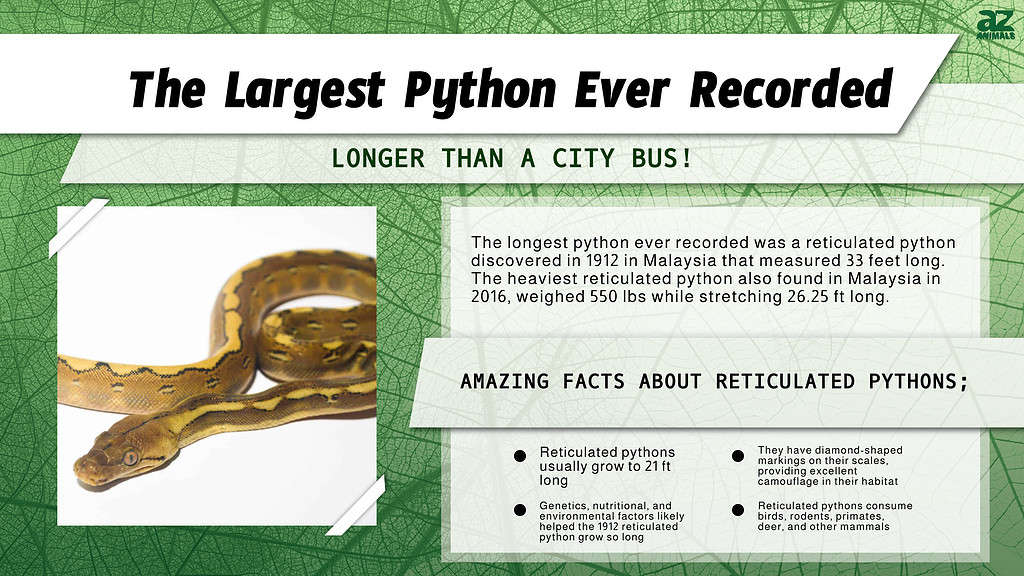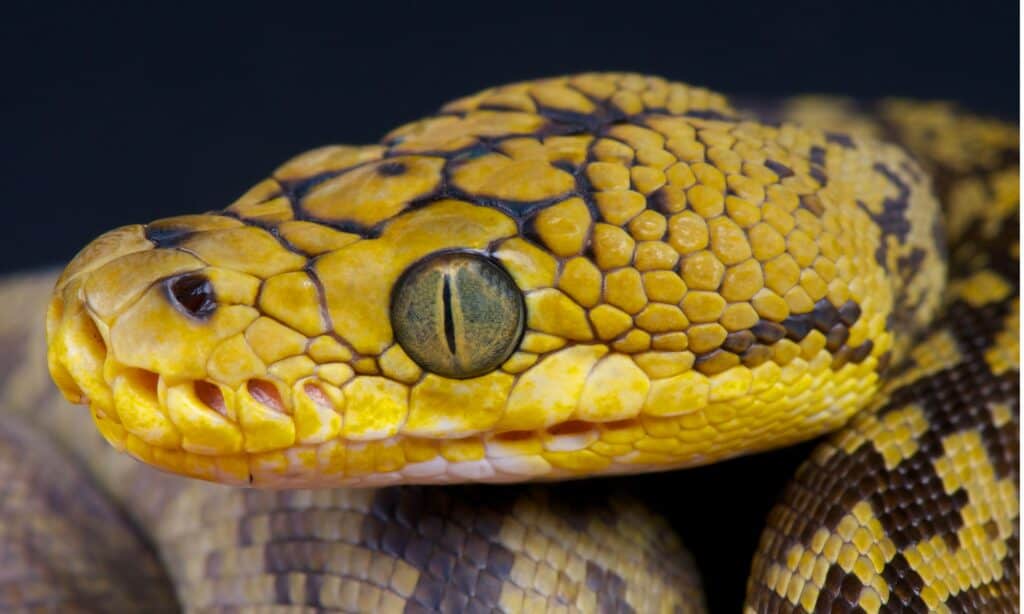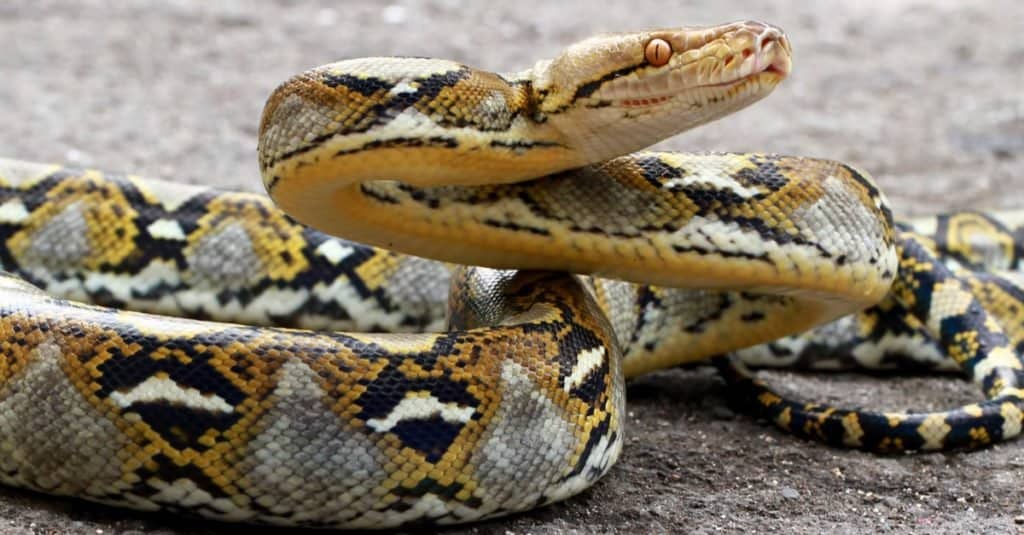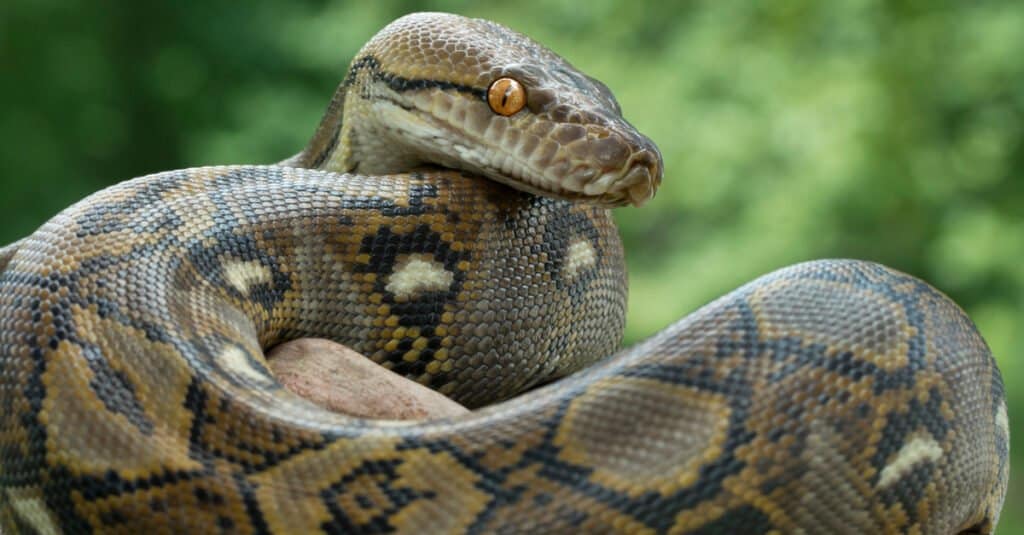Standing next to a city bus, you can’t help but be impressed by its size. But imagine discovering that a snake once existed that was even longer than the bus itself. That’s right! We’re talking about a python so enormous that it would put a city bus to shame. You might wonder how on Earth this snake grew to such an incredible size.
We’re about to embark on a thrilling adventure to uncover the reasons behind the colossal growth of the largest python ever recorded. Prepare to be amazed, intrigued, and inspired by the story of the snake that was longer than a city bus and the world of titanic serpents.

The Largest Python Ever Found
In 1912, the world was left in awe by the discovery of a reticulated python that measured a mind-boggling 33 feet (10 meters) in length. This enormous serpent was found in Indonesia’s wild, setting a record for length that remains unbeaten to this day. The sheer size of this colossal python showcases the incredible potential of these magnificent creatures and leaves us wondering what other astonishing discoveries await us in the wild.
There was also a reticulated python found on a construction site in Malaysia in 2016 that was the heaviest python ever found. Coming in at 26.25 feet long (8 meters) and weighing about 550 lbs (250kg), this creature was truly massive.
Longer Than a City Bus
To truly appreciate the magnitude of the 1912 record-breaking python, it’s helpful to compare it to something more familiar: a city bus. At 33 feet (10 meters) long, this extraordinary snake was longer than the average city bus, dwarfing the massive vehicle in length. This comparison underscores the remarkable size of this giant serpent and emphasizes the awe-inspiring nature of reticulated pythons.
Comparison with Other Large Snake Species

There was a reticulated python found in Malaysia in 2016 that was almost 27 feet long and 550 pounds.
©iStock.com/reptiles4all
While reticulated pythons are known for their impressive size, they’re not the only snake species with such a claim to fame. Green anacondas, for example, are also notable for their substantial lengths, although they typically fall short of reticulated pythons.
While green anacondas have been subject to exaggerated claims of lengths exceeding 80 feet, they rarely surpass 21 feet in reality. Comparing these two snake species highlights the truly extraordinary nature of the 1912 record-breaking reticulated python.
What Is a Reticulated Python?
As we dive into the incredible world of the largest python ever recorded, let’s first familiarize ourselves with the species responsible for this awe-inspiring record—the reticulated python, or Malayopython reticulatus.
Physical Characteristics
The reticulated python is known for its striking appearance, featuring an intricate pattern of diamond-shaped markings that run along its body. These markings provide excellent camouflage, allowing the snake to blend seamlessly with its surroundings. Adult reticulated pythons typically reach lengths of over 21 feet, making them the world’s longest snake species.

The Reticulated Python has an intricate pattern of diamond-shaped markings that run along its body.
©Opayaza12/Shutterstock.com
3 Reasons It Grew So Large?
As we unravel the mystery of the largest python ever recorded, let’s explore the factors contributing to the immense size of reticulated pythons.
#1: Genetic Factors
Genetics plays a significant role in determining the size of reticulated pythons. Variations in size are often attributable to differences in their genetic makeup. Some individuals may possess genes that predispose them to grow larger than others. Others may have traits that result in smaller sizes.
#2: Nutritional Factors
A reticulated python’s diet is another critical factor that contributes to its size. Access to a consistent and abundant food supply can significantly impact a python’s size, with well-fed individuals likely to grow larger than those with limited access to prey.
#3: Environmental Factors
The environment in which a reticulated python resides can also have a profound impact on its growth and size. Factors such as temperature, humidity, and the availability of suitable habitats can all influence the overall health and well-being of these snakes. A stable and supportive environment is essential for their continued growth and development. It allows them to achieve their full-size potential.
Bonus Reason: Age and Growth Rates
Like many other reptiles, reticulated pythons continue to grow throughout their lives, albeit at varying rates. The age of a python is a significant factor in determining its size. Older individuals are typically larger than their younger counterparts. Additionally, growth rates can vary among individuals. Some pythons may experience periods of rapid growth, while others grow more slowly.
Diet of Reticulated Pythons

Pythons are an invasive species in Florida.
©Mark_Kostich/Shutterstock.com
As we continue our journey through the fascinating world of reticulated pythons, it’s important to examine their dietary habits to understand how these incredible creatures fuel their massive bodies.
Preferred Prey
Reticulated pythons primarily consume mammals and birds, with their diet consisting of various species such as rodents, primates, and even deer. Their size and strength allow them to tackle large prey, ensuring that they receive the necessary nutrients to maintain their immense bodies. In addition, as opportunistic hunters, they are adaptable and capable of adjusting their diets based on the availability of prey in their environment.
Hunting Techniques
These skilled predators are known for their stealth and patience when it comes to hunting. Reticulated pythons typically lie in wait, using their excellent camouflage to blend into their surroundings. Next, they rely on their keen senses to detect approaching prey. Then, when the moment is right, they strike with lightning-fast speed. These nocturnal hunters are adept at ambushing their unsuspecting victims, quickly overcoming them with their powerful constriction.
Constriction and Consumption
Once a reticulated python has captured its prey, it uses its powerful muscles to constrict the victim, suffocating it before consumption. The snake then swallows its meal whole, using its highly flexible jaw and specialized skull structure to accommodate even large prey items. The python’s digestive system is equally impressive, as it can break down bones, fur, and feathers, absorbing the essential nutrients it needs for growth and maintenance.
Feeding Frequency and Metabolism
Reticulated pythons don’t need to eat as frequently as some other animals, thanks to their slow metabolism. After consuming a large meal, they can go for weeks or even months without eating again. This ability to efficiently process and store energy is crucial for their survival. In addition, it enables them to endure periods of food scarcity in their natural habitats.
Habitat Preferences and Behavior
To gain a comprehensive understanding of the largest python ever recorded, it’s crucial to explore the habitat preferences and behaviors of reticulated pythons in their natural environment.
Where do Reticulated Pythons Prefer to Live?
Reticulated pythons are native to Southeast Asia. Here, they can be found in a range of ecosystems, including rainforests, woodlands, and grasslands. As a result, their habitat preferences can vary depending on their geographic location.
In Myanmar, for instance, they are typically found in pristine forests. In contrast, they have been observed in urban environments, such as sewers, in Singapore, Indonesia, and Malaysian Borneo. This adaptability is a testament to their resilience and ability to thrive in diverse settings.
Can They Climb?
Despite their large size, reticulated pythons are exceptional climbers. They possess the strength and agility to ascend trees in search of prey or shelter. By wrapping their muscular bodies around tree trunks and branches, they can move upward with surprising ease. This arboreal ability offers them numerous advantages, such as access to a wider range of prey and escapes from potential predators.
Nocturnal Hunting and Camouflage
Reticulated pythons are primarily nocturnal, hunting under the cover of darkness. This allows them to remain hidden from both prey and potential threats. Their intricate, diamond-shaped patterns provide excellent camouflage. They enable them to blend seamlessly with their surroundings as they lie in wait for unsuspecting prey. This stealth and patience make them formidable hunters in their natural habitats.
Social and Territorial Behavior
While reticulated pythons are generally solitary animals, they may occasionally be found in close proximity to one another, particularly during the breeding season. Despite this, they are not considered social animals and typically don’t form long-term bonds. Instead, they can be territorial, defending their chosen hunting grounds and shelters from potential rivals.
The Role of Pythons in Ecosystems

Reticulated pythons are named for their pattern of interlocking diamonds.
©Nynke van Holten/Shutterstock.com
Reticulated pythons aren’t only fascinating creatures in their own right but also serve as key components of the environments in which they live. So let’s delve deeper into the ecological role of these remarkable serpents!
Predators and Population Control
As top predators, reticulated pythons help regulate the populations of their prey species, such as rodents and birds. By consuming these animals, they help keep their numbers in check, preventing overpopulation and the associated strain on resources. This natural population control is an essential component of maintaining balanced and healthy ecosystems.
Prey for Other Species
While reticulated pythons are formidable predators, they are not immune to predation themselves. In addition, they serve as a food source for various other species, including large birds of prey, crocodiles, and even other snakes. By providing nourishment for these animals, reticulated pythons contribute to the flow of energy through their ecosystems, supporting the survival and success of other species.
Seed Dispersal and Nutrient Cycling
Though it may not be immediately apparent, reticulated pythons can also play a role in seed dispersal and nutrient cycling within their ecosystems. The digestion and excretion of prey items can result in the dispersal of seeds contained within the prey’s digestive systems, promoting plant growth and regeneration. Additionally, the waste produced by pythons contributes to nutrient cycling, providing valuable resources for plants and other organisms in their environment.
Indicators of Ecosystem Health
The presence and well-being of reticulated pythons can serve as an indicator of the overall health of their ecosystems. Because they rely on a diverse array of prey species and suitable habitats, their population dynamics can provide insights into the health of the broader environment. A decline in python numbers, for example, could signal issues with prey availability, habitat degradation, or other factors that may warrant further investigation and conservation efforts.
Threats Facing Pythons
While reticulated pythons are undoubtedly fascinating and impressive creatures, they are not without their share of challenges. Let’s shed some light on the dangers these incredible snakes face and the importance of addressing these threats to ensure their survival.
Habitat Loss and Fragmentation
One of the most significant threats to reticulated pythons is the loss and fragmentation of their habitats. Deforestation, agriculture, and urbanization have led to the destruction of vast swaths of their natural environments, leaving them with fewer places to live, hunt, and reproduce. This loss of habitat not only reduces their population size but also makes it more challenging for them to find suitable mates, resulting in a decline in genetic diversity.
Poaching and Illegal Trade
Poaching and illegal trade are other significant threats to reticulated pythons. These snakes are highly sought after for their skin, which is used in the fashion industry to produce luxury items such as handbags and shoes. Additionally, they are often captured and sold as exotic pets, sometimes leading to their mistreatment and poor living conditions. The demand for pythons in these markets puts immense pressure on their populations and contributes to their decline.
Human-Wildlife Conflict
As human populations expand and encroach on python habitats, conflicts between humans and pythons are becoming increasingly common. Pythons may be killed by frightened or angry people who view them as threatening their safety or property, further reducing their numbers. Additionally, pythons may suffer injuries or death from encounters with vehicles, fences, and other human-made structures.
Climate Change
Climate change poses yet another threat to reticulated pythons. As temperatures rise and weather patterns become more unpredictable, the habitats these snakes rely on may become unsuitable for their survival. Shifts in climate can also impact their prey populations, making it more difficult for pythons to find sufficient food sources.
Key Takeaways
And so, our journey into the mesmerizing world of reticulated pythons comes to an end. We’ve marveled at their extraordinary size and discovered the secrets behind their record-breaking lengths. Along the way, we’ve also gained a deeper understanding of their unique ecology and the essential roles they play within their ecosystems.
However, it’s crucial to remember that these magnificent creatures face various threats in today’s rapidly changing world. By raising awareness of their plight, we can all play a part in protecting and preserving these awe-inspiring snakes for generations to come. Whether it’s supporting conservation organizations, promoting ethical wildlife tourism, or simply educating others about the importance of these giant serpents, every action counts.
The photo featured at the top of this post is © Mark_Kostich/Shutterstock.com
Discover the "Monster" Snake 5X Bigger than an Anaconda
Every day A-Z Animals sends out some of the most incredible facts in the world from our free newsletter. Want to discover the 10 most beautiful snakes in the world, a "snake island" where you're never more than 3 feet from danger, or a "monster" snake 5X larger than an anaconda? Then sign up right now and you'll start receiving our daily newsletter absolutely free.
Thank you for reading! Have some feedback for us? Contact the AZ Animals editorial team.







